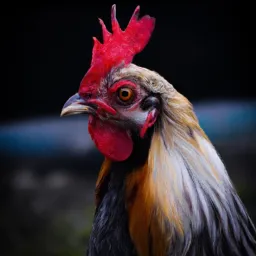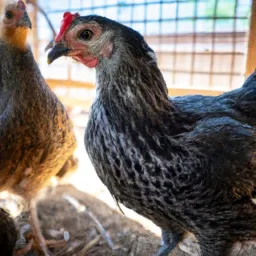Become An Insider On Poultry Terms
Chicken terms, chicken terms and definitions, chicken terminology… Poultry Terms…
Whichever way you like to call it, there is an insider language all of its own when you walk into the world of chickens.
So to help you sound like an expert when talking to other chicken fanciers, let’s get armed and learn these chicken terms to dazzle your friends.
Poultry Terms To Know And Show Off With
Poultry Terms B – M
Familiarize yourself with these poultry terms to get a hold of chicken raising.
Bantam – a chicken variety that is about half the size of the standard breed of chickens. These breeds are usually bred for ornamental reasons.
Bedding – can either be shavings of wood, haystack pile, or newspaper that are added to the floor of the coop and inside a nest box.
The purpose of this is for absorption of droppings and the odour of chicken poop.
It also provides a cushion for eggs to be safely ejected from their mother without the worry of breaking it.
Brood – this could either mean the hens incubating their chicks or a flock of baby chickens.
Broodiness – a chicken’s desire to incubate their babies – unfertilized or fertilized. Broodiness can make an egg hatch or spoil it.
There are a lot of factors that may arise in being broody. And the mother is a bit moody when she is manifesting broodiness.
Candling – is a procedure wherein a candle or a light bulb is used. It is the process of letting light shine through an egg to determine if it is fertilised or not.
Candling can be useful especially if you are planning to separate the eggs from growing embryos and those that you wanted to sell.
Capon – a rooster that has been castrated.

Clutch – fertilized egg groups that hens tend to incubate.
Cockerel – a juvenile or young rooster.
Comb – this is the rubbery, red flat piece of flesh hanging on top of a chicken’s head. Roosters have a more prominent comb than hens.
Some who are engaged in cockfighting preferred to cut the rooster’s comb so as not to interfere with the fight.
Coop – house of chickens.
Crop – Part of a chicken’s digestive system that can be found in the oesophagus wherein food is first digested before entering the stomach.
Droppings Tray – a tray that collects chicken droppings, which is located under poles for quick disposal.
Dust bath – A pattern of chicken behaviour wherein they dig a hole in the ground and immerse their bodies in the earth that has been loosened.
See also Eggs Organic - Hold on, are Hens Eggs Really Organic?
They will get down and dirty until they get satisfied.
Bathing in the dust is a kind of defence mechanism to protect chickens from lice and mites that may invade their feathers and feed on their blood.
A dust bath can either be natural or artificial.
Feeder – a container that delivers and holds feeds for chickens.
Fertilized egg – an egg that came from the mating of a rooster and a hen and is destined to become a baby.
Grit – bits of rock or sand bits that chickens tend to eat and is stored in the crop that is important for good digestion.
Hackles – chicken’s neck feathers.
Hen – female chicken.
Incubation – the process of egg hatching in which the application of heat is required.
The eggs that are incubated are those that are already fertilized.
Constant heat, usual turning, and an environment that is humid are the essential needs of an egg that also comes in with the period.
Incubation takes about 21 days before the eggs are expected to hatch.
Layer feed – a feed that is complete and is made for the sake of laying hens.
Molt or moulting – this is the process of feather shedding and re-growing which happens once a year.
When moulting season comes, laying season is suspended.
Poultry Terms from N – W
It is necessary to know all the poultry terms needed for raising chickens for you to be more equipped on what to buy or need.
With this information, you can fully comprehend what needs to be done to raise chickens effectively.
Nest box – a box, usually improvised, that is designed for hens to lay their eggs. It is a requirement that for a number amounting to 4 to 5 hens, one nesting box is needed.
Non-setter – this is a kind of chicken breed that doesn’t have any desire to care for their chicks if they have one, or never wanted to incubate or hatch fertilised eggs.
Ornamental breed – a kind of chicken that is used only for ornamental purposes and nothing more. These breeds are the ones that are often seen in fairs and poultry shows.
They are appreciated because of their stunning stature and appearance but not used for producing eggs and chicken meat.
Poultry show – this is a kind of show that is organized for the sake of judgment.
See also Owning Chickens In The City Nest Egg
The proudest breeds are displayed and are judged according to their standard breed.
This show is organized by the APA or American Poultry Association.
Not only chickens are brought to this kind of affair but also other poultries like geese, ducks, turkeys, etc.
Production breed – are the kind of breeds that are used for mass production of eggs.
Pullet – a juvenile or young hen.
Roost – the time when chickens are resting on a pole to sleep. It is also what you call the actual pole where chickens use to perch.
Rooster – male chicken.
Roosting pole – a perch that is made out of wood. It can be constructed and put inside the coop.
Rumples – a kind of chicken breed that does not have feathers on their tails.
Run – an area connected to the coop where chickens can roam around freely.
Scratch – a treat made for chickens that are composed of different kinds of grains; this is the one that is scattered on the ground.
It can also be referred to as the behaviour chickens make wherein they use their claws to dig up either worms, bugs, rocks, and tiny little insects that are inside the ground.
Sexing – determining the sex of a chicken.
Sex link – a type of new chicken wherein the chicken’s sex is soon indicated even before the eggs hatch. Female of the sex link kind is known for producing eggs in a massive state.
Shanks – part of the chicken’s legs that can be seen at the bottom.
Sickles – what is called the rooster’s tail feathers.
Spur – this is the protrusion that is seen on the shank of a rooster that is used for fighting.
Started pullet – a hen that has started laying eggs but is only on a juvenile stage.
Starter feed – it’s the complete feed that is formulated and made especially for baby chicks.

Vent – part of the chicken where poop, eggs and other waste matters pass. It’s like the anus of humans.
Waterer – this is the trusty partner of the feeder which delivers and holds the water supply.
Wattles – it’s similar to a chicken’s crow but instead of being on top of the head, it’s found under the neck of the chicken. Its composition is red and has rubber-like flaps.
Wheezer – in colloquial terms, it’s what they call a chicken’s butt.
